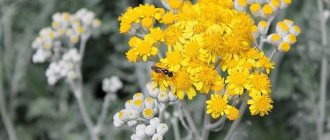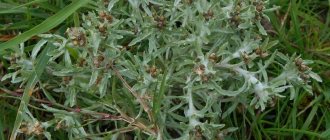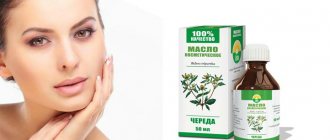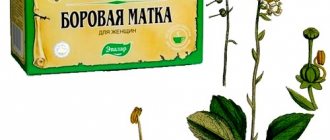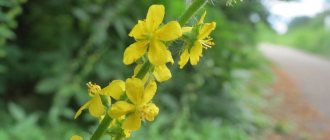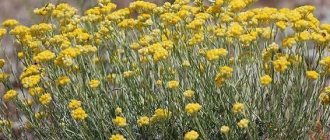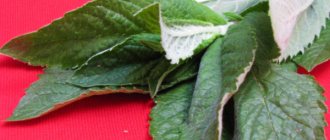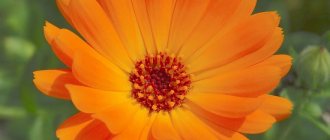If there are contraindications, you should consult a specialist (doctor).
Wormwood has been used as a medicine since ancient times and is distributed over a large area: in Russia - from the western border to the Ob and Yenisei, in the north it is found up to Arkhangelsk. Outside Russia it grows throughout Europe and North America. Places of origin: presumably Europe, North Africa and Western Asia. In addition to growing wild, wormwood is cultivated to produce valuable oil. It grows in many places near human settlements and in forests. There are a number of names: “God’s tree”, true wormwood, wormwood, white wormwood.
Botanical description
It grows from 50 to 200 cm, often as a subshrub, the pubescence is similar to silvery felt, the shoots are erect, the root is taprooted, branched. The stems are straight, almost smooth, branch upward, often with short, sterile shoots located at the base.
At the bottom of the plant there are leaves with long petioles, dissected two or three times, in the middle of the plant the leaves have short petioles, dissected twice, at the top of the wormwood leaves are almost sessile, pinnate or dissected twice, parts of all leaves are pointed. All flowers are tubular in structure, yellow in color, the outer ones are pistillate, and in the middle are bisexual. The baskets are balls, 2.5–3.5 mm in diameter, located on short branches in one-sided tassels, which create a narrow panicle-shaped inflorescence.
The baskets are wrapped in imbricated skin, the leaves have a wide film. A convex receptacle with hairs predominates. Wormwood blooms in June–July on the European territory of Russia. The fruits grow in the form of sharp brownish seeds, approximately 1 mm long, oblong in shape, similar to wedges, with thin grooves, with a round, slightly convex area at the top. Fruit ripening occurs in August–September. Reproduction occurs by seeds; wormwood tolerates frost and dry weather well.
How to find
Wormwood can reach 180 cm in height and is often confused with hemlock. However, they are distinguished by height, stem color and flower appearance. First of all, hemlock is twice as tall. Its stem is green with purple spots, while the stem of mugwort is entirely purple. Hemlock flowers are white with five petals and shaped like an inverted umbrella. Wormwood flowers are pale yellow or red, they are located evenly along the entire stem.
Wormwood leaves grow “alternately” along a purple, grooved stem, with a lighter shade or silver color underneath.
Sagebrush
Wormwood is found on sale in different forms. Always choose a product from a trusted and reliable manufacturer, and consult your doctor before use. Wormwood can be purchased in the form of:
- essential oil
- dry collection
- tea
- seeds
- incense
- powder
Composition and nutrients
The part of wormwood growing above the ground at the time of flowering, and the leaves before flowering, contains sesquiterpene lactones and bitter glycosides (artabsin, absinthine, anabsinthine), which creates the bitter taste of wormwood.
Also included are:
- ascorbic acid;
- saponins;
- tannins;
- flavonoids;
- artemisetin;
- essential oil;
- potassium salts;
- carotene;
- malic and succinic acids;
- phytoncides;
- resinous substances;
- ketolactones “A” and “B”;
- ortabsin;
- prochamazulenogen;
- oxylactone.
Wormwood contains essential oil: it is a thick liquid, blue or dark green in color, and has a strong bitter taste. The oil is isolated from the plant using steam distillation and the product contains:
- curcumen;
- thujone;
- β-caryophyllene;
- cadinene;
- thuyl alcohol;
- pinene;
- γ-selinene;
- chamazulenogen;
- β-bisick;
- phellandrene.
Use in the food industry
Even in Ancient Egypt, wormwood was added as a seasoning to food, or rather to alcohol. Mainly for wines. The tradition of using Chernobyl in the preparation of alcoholic beverages continued in France in the 19th century. At that time, absinthe was popular, especially among bohemians. However, in those days, absinthe contained a lot of the toxic substance thujone, which has a detrimental effect on the central nervous system and causes addiction. Today, absinthe is safer.
Sometimes wormwood is added as a herb to fatty meat dishes, including goose, duck or lamb. It is believed that a small amount of this herb improves the taste of the finished dish. Fresh leaves are also added to some cocktails. In Morocco, for example, a small piece of Chernobyl leaf is traditionally added to a mixture of mint and green tea. This drink leaves an unusual bitter aftertaste. But in this matter, the main thing is not to overdo it, otherwise the tea will become very bitter and have an unpleasant odor. Surprisingly, the bitter taste of wormwood tea remains even if it is diluted in a ratio of 1:800. But it was precisely because of its bitterness that this herb in microdoses was once so often added to various sauces. Today, wormwood is used primarily for the preparation of bitters, vermouths, liqueurs, and flavored vodka.
Medicinal properties of wormwood
Traditionally, wormwood has always had pharmaceutical and botanical significance and has been used to treat a number of diseases, including hepatocyte enlargement, hepatitis, gastritis, jaundice, wound healing, splenomegaly, dyspepsia, indigestion, flatulence, stomach pain, anemia and anorexia. Mugwort has also been documented to have antioxidant, antifungal, antimicrobial, anthelmintic, antiulcer, anticancer, hepatoprotective, neuroprotective, antidepressant, analgesic, immunomodulatory, and cytotoxic activities. Combination chemotherapy of mugwort extract, or its isolated active components, with antimalarial drugs has been documented to help relieve malaria and piroplasmosis infections1.
Due to irritation of the nerve endings of taste buds in the oral cavity, the active components of wormwood stimulate the gastrointestinal glands (the production of bile and pancreatic juice increases). Wormwood essential oil acts on the central nervous system like camphor. Chamazulene activates the immune and excretory functions, which explains the laxative and anti-inflammatory effect of the plant.
Natural medicines from Chernobyl
To improve appetite three times a day, half an hour before meals, it is useful to drink a teaspoon of wormwood wine. Medicinal wine is prepared from 3-5 tablespoons of chopped herbs and half a glass of 40% alcohol. The ingredients are mixed and left for 24 hours. Then add 1 liter of white wine and leave overnight. In the morning, strain and can be consumed.
Wormwood tincture retains all the healing properties of the herb. But most often this medicine is used for diseases of the digestive system. In particular, with diarrhea, abdominal pain, indigestion. Prepare the tincture as follows. Fill the bottle with young leaves of grass and add alcohol. Leave in a warm place for a week, then strain. The strength of the finished tincture can be reduced by adding water to it. For severe diarrhea, take this medicine one tablespoon every 3 hours. In other cases, it is enough to consume 1 tablespoon per day.
And here is another popular recipe for Chernobyl tincture, which herbalists advise drinking a tablespoon 2-3 times a day to cleanse the blood and for stomach upsets. In a vessel put 3 dry branches of wormwood, 5 St. John's wort inflorescences with leaves, 1 geranium leaf, 8 black pepper grains, 10 raisins, 10 g of green tea, 1 tablespoon of honey and a liter of vodka. Close the vessel, wrap it in cloth and place in a pan of hot water for 2 hours. Then the mixture is infused for a week, after which it is filtered through several layers of gauze.
Use of wormwood
Wormwood is used in the treatment of diseases, in cosmetology, cooking, and dietetics. The properties of wormwood are also studied by the scientific community, and numerous studies are conducted2.
What exactly is used and in what form
Conditions of dim light and the shady side of the soil are more suitable for growing wormwood. The plant is easily propagated by dividing the roots in the fall, by cuttings or by seeds sown soon after they ripen. No further maintenance is required other than getting rid of weeds. Wormwood is planted at a distance of about 60 cm from each other.
The leaves and tops of the plant are collected in July and August, when wormwood is in bloom, and dried. The main component is a volatile oil, the yield of which during distillation ranges from 0.5 to 1.0 percent. It is usually dark green and sometimes blue in color, has a strong odor and a bitter, acrid taste.
The flowers, dried and ground into powder, are most effective as an anthelmintic and were formerly considered excellent for fevers. The essential oil of the herb is used as a dewormer4.
The leaves and flowering leaf tops are used for medicinal purposes. Harvesting takes place in two stages: the leaves near the roots are cut off without petioles until the plant blooms, at the moment of budding. The tops are plucked 20–25 cm long from the top; If you miss the deadline, the medicinal properties of wormwood are significantly reduced. If collected later, the flowers turn brown and lose their yellow color. To avoid darkening of the raw materials, wormwood is placed in baskets and dried in a shady place: in attics, under sheds, in the open air or in special dryers at 40–50 degrees Celsius. In this case, it is necessary to spread it in a layer of about 3–5 cm and periodically turn it over. Dried stems should be brittle. To keep the raw materials in the required condition, wormwood is placed in fabric bags made of natural materials or in wooden containers; the shelf life is two years.
In official medicine
Official medicine also studies the properties of wormwood. The many positive qualities of this herb have been scientifically proven. Many properties and application possibilities remain to be discovered by the scientific community. This definitely takes time and testing on real examples (1, 2). Increasingly successful rates of cancer treatment with alternative methods using plants are steering the scientific world towards natural plant resources. The antitumor properties of wormwood extract were studied on human colon, endometrial and embryonic kidney cancer cells.
As a result of the study, it was found that wormwood extract exhibits antioxidant properties, the most effective components of which are chlorogenic, quinic, cinnamic acids, roifolin and malic acid. Artemisia extract showed inhibitory activity against DLD-1 and ECC-1 cancer cells, while the inhibitory effect against HEK-293 cells was determined to be low. Thus, it was found that the components of the extract increase the intracellular amount of free radicals on cancer cells, which in turn leads to DNA damage and, consequently, to the death of cancer cells2.
In folk medicine
Wormwood has always been very widely used in folk medicine in many countries. In ancient times, during the Olympic Games, athletes relieved tension in their muscles and nerves using a drink made from wormwood. Nowadays, healers successfully use wormwood in their medicinal potions and decoctions.
To facilitate the fight against alcohol addiction, use a decoction of wormwood with oregano:
- add four tablespoons of oregano and one tablespoon of chopped wormwood herb to one glass of water;
- the broth must be boiled and strained;
- take one tablespoon three times a day for two to three months;
- After about two weeks of using the decoction, it becomes much easier for alcohol addicts to give up alcohol, even complete refusal is possible.
Wormwood tea, prepared from 28 grams of herb, infused for 10-12 minutes in 0.5 liters of boiling water and taken in glass doses, will relieve melancholy and help get rid of the yellow tint on the skin during hepatitis. It will also be a good stomachic remedy, and with the addition of a fixed alkaline salt obtained from a burnt plant, it is a powerful diuretic in some cases. The ash produces a purer alkaline salt than most other vegetables.
The juice of the larger leaves, which grow from the root before the stem emerges, has been used as a remedy for jaundice and dropsy, but it causes severe nausea if not dosed correctly. A light infusion of the tops of the plant, used fresh, is excellent for all stomach disorders, creating appetite, promoting digestion and preventing nausea after eating, but in overdose it has the opposite effect4.
In oriental medicine
Avicenna himself healed ailments using wormwood. A famous doctor treated inflammation of the eyes with a decoction of wormwood, also expelled helminths with the help of the plant, and prescribed it to women to normalize the cycle. Avicenna used fresh juice to treat jaundice and dropsy. In Central Asia, an infusion of wormwood flowers is used to combat hemorrhoids, irritation of the cecum, epilepsy, ulcerative colitis and halitosis. In India, wormwood is used as an anthelmintic and tonic.
Externally:
Hemostatic. Anti-inflammatory. Painkiller. Wound healing. For lotions and compresses for bruises. For purulent wounds and ulcers. Allergies.
Wormwood has an analgesic effect on bruises, sprains, dislocations, spasms and inflammation of the colon. The use of wormwood is contraindicated during pregnancy. Due to its toxicity, caution should be exercised when used internally. Excessive use of wormwood preparations can cause seizures, convulsions, and hallucinations.
In Russian folk medicine, a decoction of wormwood herb is used for fever, diseases of the liver, stomach and spleen, and dropsy. Fresh juice mixed with alcohol for kidney stones, insomnia, as an anthelmintic and wound healing agent. In folk medicine of Central Asia, an infusion of wormwood flowers is used for ulcerative colitis, inflammation in the cecum, hemorrhoids, bad breath, epilepsy and a number of other diseases.
How to properly collect and prepare
Best materials of the month
- Coronaviruses: SARS-CoV-2 (COVID-19)
- Antibiotics for the prevention and treatment of COVID-19: how effective are they?
- The most common "office" diseases
- Does vodka kill coronavirus?
- How to stay alive on our roads?
Dried wormwood either does not contain thujone at all or is present in negligible quantities, which makes the dry plant safe for consumption. A medicinal infusion of Chernobyl is prepared from half a teaspoon of dry herbs and a glass of boiling water, the mixture is infused for 15 minutes. You can give a little more herb, but in this case the result is a very bitter infusion that is impossible to drink. The same applies to drinks aged for more than 15 minutes.
But no matter how bitter wormwood tea is, it is undesirable to add sweeteners to it, since sugar affects the medicinal properties of the herb. You can minimize the bitter taste by adding mint and anise to your tea. Wormwood is drunk in small sips.

